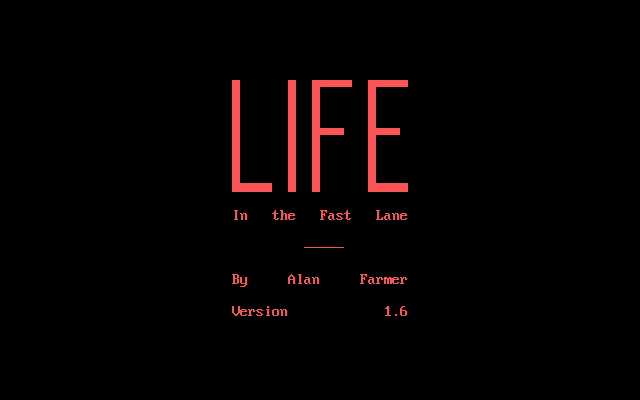Retro Replay Review
Gameplay
Life in the Fast Lane offers a surprisingly hands-on approach to cellular automata, giving players full control over the evolution of initial patterns. You can draw your own seed configurations cell by cell, or opt for a completely random start to see how chaos unfolds. Once your pattern is set, the simulation begins in real time or under step-by-step control, making it easy to examine each generation in detail.
(HEY YOU!! We hope you enjoy! We try not to run ads. So basically, this is a very expensive hobby running this site. Please consider joining us for updates, forums, and more. Network w/ us to make some cash or friends while retro gaming, and you can win some free retro games for posting. Okay, carry on 👍)
Beyond the classic Conway’s Game of Life rules, this version introduces a “3-4 variant” algorithm, opening up fresh possibilities for emergent behavior. You can switch between the standard and variant rule sets with a single keystroke, then immediately watch how familiar gliders or oscillators behave under different conditions. A speed slider allows you to slow things down to pencil-and-paper pace or ramp up the action for a cascading blur of cell births and deaths.
Controls are straightforward and responsive. Cursor keys let you pan around the grid, while dedicated hotkeys handle functions like randomizing the field, clearing the screen, or toggling the wrap-around edges feature (for continuous, toroidal simulations). For those who want quick results, pre-built patterns can be loaded from a small library, saving you the effort of redrawing well-known constructs like the glider gun or pulsar.
Graphics
The visual presentation of Life in the Fast Lane is delightfully minimalist. On monochrome or early‐era color displays, the grid is rendered as a simple array of squares, each toggling between “alive” and “dead” states with a clean, flicker-free animation. While there’s no fancy shading or texture, the clarity of each cell’s state is never in doubt, even on lower-resolution screens.
Cell colors can be customized to suit your taste or monitor limitations—switch from black-and-white to contrasting hues for easier tracking of complex patterns. The interface includes a thin status bar showing generation count, live cell tally, and current rule set, all in legible text that doesn’t interfere with the simulation itself.
Transitions between generations are buttery smooth, thanks to efficient memory handling and an optimized redraw routine. Whether you’re watching a small cluster evolve or a sprawling field of shapes cascade across the screen, the animation pace remains rock solid, with no dropped frames or stutter even at maximum speed.
Story
Strictly speaking, Life in the Fast Lane isn’t a story‐driven title—it’s an open sandbox for exploring emergent phenomena. However, the lineage of this simulation traces back to John Horton Conway and his landmark invention, the Game of Life. Released as part of Big Blue Disk #28, it brings Conway’s mathematical experiment straight to your home computer.
Playing the game feels like stepping into a laboratory of artificial life. There’s a certain narrative quality in the way simple initial conditions can tell an unexpected “story” of growth, decline, and renewal. From the emergence of self-replicating structures to the dramatic collisions of gliders, each simulation can unfold like a micro-drama with its own unpredictable arc.
Though there’s no traditional plot or characters, you as the observer assume the role of a cosmic architect. By altering the ruleset or initial layout, you influence the destiny of thousands of virtual cells. This meta-narrative—your influence shaping life and death across the grid—is where the true “story” of Life in the Fast Lane resides.
Overall Experience
Life in the Fast Lane offers a remarkably polished rendition of a classic mathematical puzzle. Its intuitive controls, combined with flexible rule options and real-time or discrete stepping, make it both a powerful educational tool and an endlessly replayable toy. Novices can jump in with random patterns, while enthusiasts will appreciate the fine-tuning options and built-in pattern library.
While it lacks the flash of modern video games, its minimalist charm is precisely what keeps you focused on the evolving patterns. The unobtrusive interface and responsive performance ensure you never lose sight of the core appeal: watching fascinating emergent behaviors unfold before your eyes.
For educators, hobbyists, and anyone curious about the boundary between order and chaos, Life in the Fast Lane is a must-have. Its combination of manual pattern design, random generation, and variant rule sets turns a simple cellular automaton into a rich playground of discovery. Whether you’re tracking oscillators or inventing new glider patterns, you’ll find yourself drawn back to the grid time and again.
 Retro Replay Retro Replay gaming reviews, news, emulation, geek stuff and more!
Retro Replay Retro Replay gaming reviews, news, emulation, geek stuff and more!






Reviews
There are no reviews yet.